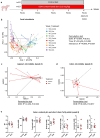Butyrate reduces epithelial barrier dysfunction induced by the foodborne mycotoxin deoxynivalenol in cell monolayers derived from pig jejunum organoids
- PMID: 39572558
- PMCID: PMC11587856
- DOI: 10.1080/19490976.2024.2430424
Butyrate reduces epithelial barrier dysfunction induced by the foodborne mycotoxin deoxynivalenol in cell monolayers derived from pig jejunum organoids
Abstract
The foodborne mycotoxin deoxynivalenol (DON) produced by Fusarium species threats animal and human health through disruption of the intestinal barrier. Targeting the gut microbiota and its products appears as a promising strategy to mitigate DON intestinal toxicity. In this study, we investigated whether the bacterial metabolite butyrate could alleviate epithelial barrier disruption induced by DON. We used a model of cell monolayers derived from porcine jejunum organoids allowing to reproduce the cellular complexity of the intestinal epithelium. Our results show that DON dose-dependently disrupted the epithelial barrier integrity, reduced epithelial differentiation, and altered innate immune defenses. Butyrate attenuated the DON-induced increase in paracellular permeability. Butyrate also prevented epithelial barrier dysfunction triggered by anisomycin, a ribosome inhibitor like DON. Moreover, butyrate partially counteracted the effects of DON on tight junctions (TJP1, OCLN), innate epithelial defenses (PTGS2, CD14, TLR4, TLR5), and absorptive cell functions (CA2, VIL1, NHE3, CFTR). In contrast, butyrate did not prevent the toxic effects of DON on mitochondrial metabolism, proliferation and goblet cell functions. Taken together, our results demonstrate that the bacterial metabolite butyrate is able to reduce DON-induced epithelial barrier disruption.
Keywords: Gut microbiota; enteroids; epithelium; metabolites; permeability; toxin.
Conflict of interest statement
No potential conflict of interest was reported by the author(s).
Figures












References
-
- Knutsen HK, Alexander J, Barregård L, Bignami M, Brüschweiler B, Ceccatelli S, Cottrill B, Dinovi M, Grasl-Kraupp B, Hogstrand C, et al. Risks to human and animal health related to the presence of deoxynivalenol and its acetylated and modified forms in food and feed. EFSA J. 2017;15(7):e04718. doi:10.2903/j.efsa.2017.4851. - DOI - PMC - PubMed
MeSH terms
Substances
LinkOut - more resources
Full Text Sources
Research Materials
Miscellaneous
